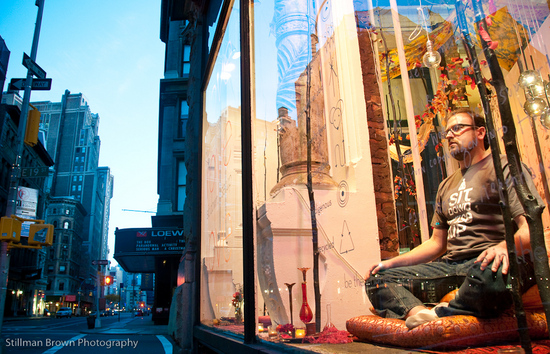Last weekend I continued my search for a spiritual practice by taking part in the Zen Mountain Monastery’s “Intro to Zen Training” Retreat, a weekend toe dipping into the Mountain and Rivers Order manifestation of Soto and Rinzai Zen Buddhism. The monastery is tucked away in the beautiful Catskill mountains, about two and half hours outside of New York City. After stepping out of the car I stood on the front lawn for a moment staring at a the yellow leaves of a ginkgo biloba tree fluttering in the wind. I thought about how special it felt to just watch the wind rearrange the landscape and was reminded of a quote by Suzuki Roshi:
“Perhaps the wind is just blowing and pine tree is just standing in the wind. That is all that they are doing. But the people who listen to the wind in the tree will write a poem, or will feel something unusual.” – Suzuki Roshi
“Buddhism is a religion”
The training weekend began with a talk by Abbott Ryushin Sensei, a tall, older man with a shaved head, thin rimmed oval glasses and a Polish accent. “Buddhism is a religion because it addresses the most basic questions of existence…” He stressed the totality of Buddhist Practice, how it leaves no area of life untouched. I wasn’t just coming here this weekend to do a lot of Sitting Meditation, or to eat my oatmeal very slowly; the monastery experience was one of immersion, you are expected to “swallow the whole fish.”
It’s the Rituals Stupid
As a mindfulness practitioner, living on a monastery for a weekend is like the world’s biggest Yankees fan moving into Yankee Stadium. Every aspect of daily life was a support for my practice, from raking the leaves in the front yard, to bowing and chanting before each meal, to the practice of wearing “boring” clothing. I had previously only considered these to be supplementary to sitting meditation practice, but on this retreat I began to see how they are really integral to a more complete practice of “Being a Buddhist”. One area that I became surprisingly enthusiastic about was the Zen Liturgy. I began the weekend with lackluster enthusiasm for the chanting and bowing that preceded Zazen, Meals, Work Practice and Going to Sleep, but by the end I found myself looking forward to being a part of what Daido Loori calls “…an affirmation or restatement of the common experience of a community”.
If Sitting Practice for a meditator is like the Yankees fan watching the action in the baseball game, then the Liturgy is like a group of Yankees fans coming together to sing Take Me Out to the Ballgame. If you have ever been part of a crowd of 60,000 people singing during the seventh inning stretch you probably understand the how amazing and powerful that experience is. Like the Yankees fans asking for “Peanuts and Cracker Jacks” and stating the basic rules of baseball, that : “3 Strikes you’re out..”, the participants in the Zen Liturgy ask for “Maha Prajna Paramita” (or Heart of Perfect Wisdom) and state the basic rules of existence: “Form is no other than emptiness, Emptiness no other than form…” My impression of Zen practice up until this point was that it was very intellectually driven and I was wondering “Where is the Heart in Zen?”, the answer I found was that “It’s the rituals stupid.”
I Don’t Care if I Ever Get Back
“Yankees fan” is a state of being, not a shroud that can be easily thrown on or off. After the game is over baseball fans don’t just stop being fans. They can buy souvenirs to decorate their homes and offices, play pick-up ball and watch the games on TV (which is no match for actually being at a game!). In the same way, as a lay practitioner leaving a monastic setting, I decided to take as much with me as would translate. Reciting the Meal Gatha before I eat and bowing to my cushion before beginning a session of meditation are two simple rituals that I’ve brought home to re-create the environment of support that I got on the monastery. I find that they help me generate momentum for mindfulness and intention setting when I’m not on the cushion.
Depth vs. Accessibility
I’m understanding with more depth now the conversation surrounding the transformation of Buddhism in the West. Some say you can strip Buddhism down to essential elements and remove the cultural trappings to make it more accessible. I was getting quite the opposite impression from the Zen community I visited last weekend; that the cultural trappings are themselves the essence of Buddhism, or to say it in a more Buddhist way: “Emptiness is Form“. You can’t take away the bowing and the chanting and the incense without removing something essential that has been developed over generations of deep practice.
I am grateful for the opportunity to have a more casual introduction to Buddhism via places like the IDProject and NY Insight, but what I want most now is to cast myself deep into practice. I understand the difference between wearing robes to meditate and wearing a neon print t-shirt. I understand the difference between silently mouthing a meal gatha to myself or chanting it out loud with a group. The question I need to answer is, can I integrate these things into my life without living on a monastery?
What do you think?


